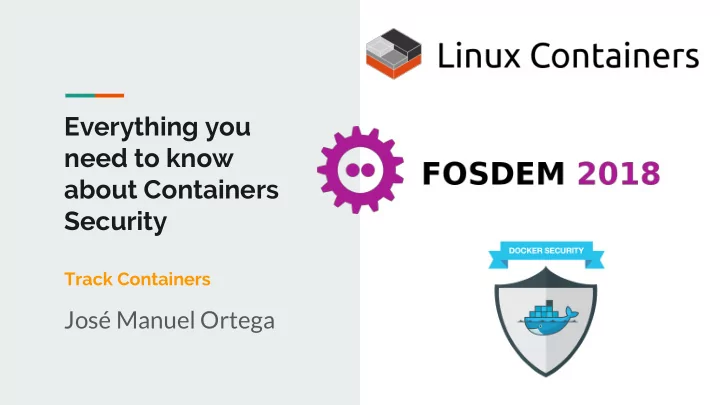

Everything you need to know about Containers Security Track Containers José Manuel Ortega
@jmortegac
Agenda ● Introduction to containers security ● Linux Containers(LXC) ● Docker Security ● Security pipeline && Container threats ● Tools for auditing container images
Virtualization vs containers
Virtualization vs containers
Security mechanims
Namespaces ● Provides an isolated view of the system where processes cannot see other processes in other containers ● Each container also gets its own network stack. ● A container doesn’t get privileged access to the sockets or interfaces of another container.
Cgroups && capabilities ● Cgroups: kernel feature that limits and isolates the resource usage (CPU, memory, network) of a collection of processes. ● Linux Capabilities: divides the privileges of root into distinct units and smaller groups of privileges
Linux Containers(LXC)
LXC ● Lightweight virtual machines ● VMs without the hypervisor ● Kernel namespaces ● Apparmor and SELinux profiles ● Seccomp policies ● Kernel capabilities and Control groups
LXC
LXC:limit resources
LXC:limit resources
Docker
Container pipeline
Docker images
Docker security ● Isolation via kernel namespaces ● Aditional layer of security Apparmor, SELinux, GRSEC ● Each container gets its own network stack ● Control groups for resources limiting ● Other interesting features….
Docker Content Trust ● We can verify the integrity of the image ● Checksum validation when pulling image from docker hub ● Pulling by digest to enforce consistent
Docker Capabilites ● A capability is a unix action a user can perform ● Goal is to restrict “capabilities” ● Privileged process = all the capabilities! ● Unprivileged process = check individual user capabilities ● Example Capabilities: ○ CAP_CHOWN ○ CAP_NET_RAW
Containers security is about limiting and controlling the attack surface on the kernel.
Least privilege principle ● Do not run processes in a container as root to avoid root access from attackers. ● Enable User-namespace ● Run filesystems as read-only so that attackers can not overwrite data or save malicious scripts to file. ● Cut down the kernel calls that a container can make to reduce the potential attack surface.
Read only containers & volumes
Seccomp ● Restricts system calls based on a policy ● Block/limit things like: ○ Kernel manipulation (init_module, finit_module, delete_module) ○ Executing mount options ○ Change permissions ○ Change owner and groups
Docker bench security ● Auditing docker environment and containers ● Open-source tool for running automated tests ● Inspired by the CIS Docker 1.11 benchmark ● Runs against containers currently running on same host ● Checks for AppArmor, read-only volumes, etc... https://github.com/docker/docker-bench-securit y
Docker bench security ● The host configuration ● The Docker daemon configuration ● The Docker daemon configuration files ● Container images and build files ● Container runtime ● Docker security operations
Lynis ● https://github.com/CISOfy/lynis-docker ● Lynis is a Linux, Mac and Unix security auditing and system hardening tool that includes a module to audit Dockerfiles. ● lynis audit system ● lynis audit dockerfile <file>
Security Pipeline
CI/CD
CI/CD
Container threats
● Kernel Exploits(Dirty Cow exploit) ● Vulnerabilities like the glibc buffer overflow ● SQL injection attacks ● MongoDB and ElasticSearch ransomware attacks
Remember ● Don’t run containers as root ● Drop all capabilities and enable only needed ● Enable user namespaces ● Use seccomp for limit syscalls for avoid kernel exploits ● Keep the host kernel updated with last patches ● Mount volumes with read only
Audit Container Images
● You can scan your images for known vulnerabilities ● Find known vulnerable binaries ○ Docker Security Scanning ○ Anchore Cloud ○ Dagda ○ Tenable.io Container Security ●
Docker security scanning
Docker security scanning
Anchore
Anchore
Anchore
Dagda
Tenable.io container security
References https://docs.docker.com/engine/security ● http://www.oreilly.com/webops-perf/free/files/docker-securi ● ty.pdf http://container-solutions.com/content/uploads/2015/06/15.0 ● 6.15_DockerCheatSheet_A2.pdf Docker Content Trust ● https://docs.docker.com/engine/security/trust/content_trust Docker Security Scanning ● https://docs.docker.com/docker-cloud/builds/image-scan ● https://blog.docker.com/2016/04/docker-security ● http://softwaretester.info/docker-audit ● ●
Thanks! Contact: @jmortegac jmortega.github.io about.me/jmortegac
Recommend
More recommend